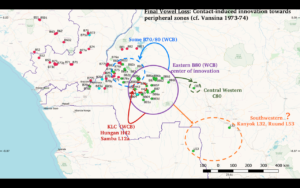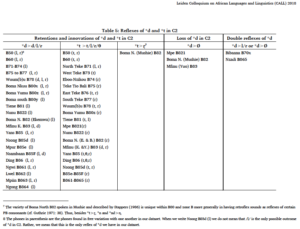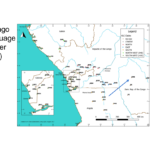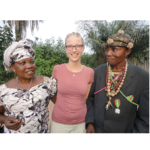 Progress on the historical linguistic side of the project was presented by Sara Pacchiarotti and Koen Bostoen at the 7th International Conference on Bantu languages (SINTU 7) in Cape Town and at the 48th Colloquium on African Languages and Linguistics (CALL) 2018 in Leiden.
Progress on the historical linguistic side of the project was presented by Sara Pacchiarotti and Koen Bostoen at the 7th International Conference on Bantu languages (SINTU 7) in Cape Town and at the 48th Colloquium on African Languages and Linguistics (CALL) 2018 in Leiden.
The talk at SINTU presented preliminary results on final vowel loss in West-Coastal/West-Western Bantu languages belonging to Guthrie’s groups B50, B60, B70 and B80. Through historical comparative work, we believe that this sound change occurred systematically in some B70 and B80 languages, but not in B50 and B60. Currently, we posit that B80 languages spoken in the eastern part of Congo DRC, such as Yans (B85), Nsong (B85d), Ding (B86), Lwel (B862), Mpiin (B863), Mbuun (B87) and Nzadi (B865), were the center of innovation for final vowel loss. This historical sound change then petered out through contact towards some B70 languages spoken in the western part of Congo DRC (e.g. Teke Tio Bali B75, some East Teke B76 varieties and some South Teke B78 varieties), some languages belonging to the Kikongo Language Cluster (e.g. Hungan H42, Samba L12a), and possibly some Central Western languages, such as Bushoong (C83).
 The talk at CALL presented a preliminary assessment of diagnostic sound changes for the internal classification of West-Coastal/West-Western Bantu languages belonging to Guthrie’s groups B50, B60, B70 and B80. We observe that most Proto-Bantu consonants in C(onsonant) 1 position are maintained in these groups. In C(onsonant) 2 position, however, several consonants undergo mergers, simplification or are completely lost in some B70 and B80 languages. This tendency to lose/reduce segments in C2 position results in very eroded reflexes of reconstructed Proto-Bantu forms and is additionally “aggravated” by the loss of final vowels in some languages within these two groups. Tentatively, B50-60 languages appear to be more conservative than B70 and B80. They retain consonants in C2 position which are lost or undergo mergers in B70-80. Moreover, B50-60 languages were not affected by systematic final vowel loss. Guthrie’s B70 group appears to be fragmented, with West Teke B73 often patterning with Guthrie’s B50-60 and South and East Teke (B77, B78 and B76 respectively) patterning with B80. Lastly, Guthrie’s B80 appears to be at least two separate groups on the basis of shared phonological innovations (i.e. B81-B83 except Boma Yumu B80z vs. B85-87+ Boma Yumu B80z).
The talk at CALL presented a preliminary assessment of diagnostic sound changes for the internal classification of West-Coastal/West-Western Bantu languages belonging to Guthrie’s groups B50, B60, B70 and B80. We observe that most Proto-Bantu consonants in C(onsonant) 1 position are maintained in these groups. In C(onsonant) 2 position, however, several consonants undergo mergers, simplification or are completely lost in some B70 and B80 languages. This tendency to lose/reduce segments in C2 position results in very eroded reflexes of reconstructed Proto-Bantu forms and is additionally “aggravated” by the loss of final vowels in some languages within these two groups. Tentatively, B50-60 languages appear to be more conservative than B70 and B80. They retain consonants in C2 position which are lost or undergo mergers in B70-80. Moreover, B50-60 languages were not affected by systematic final vowel loss. Guthrie’s B70 group appears to be fragmented, with West Teke B73 often patterning with Guthrie’s B50-60 and South and East Teke (B77, B78 and B76 respectively) patterning with B80. Lastly, Guthrie’s B80 appears to be at least two separate groups on the basis of shared phonological innovations (i.e. B81-B83 except Boma Yumu B80z vs. B85-87+ Boma Yumu B80z).
Some aspects of this new research have been incorporated in an interactive map that can be found here: West-Coastal Bantu Interactive Map.


